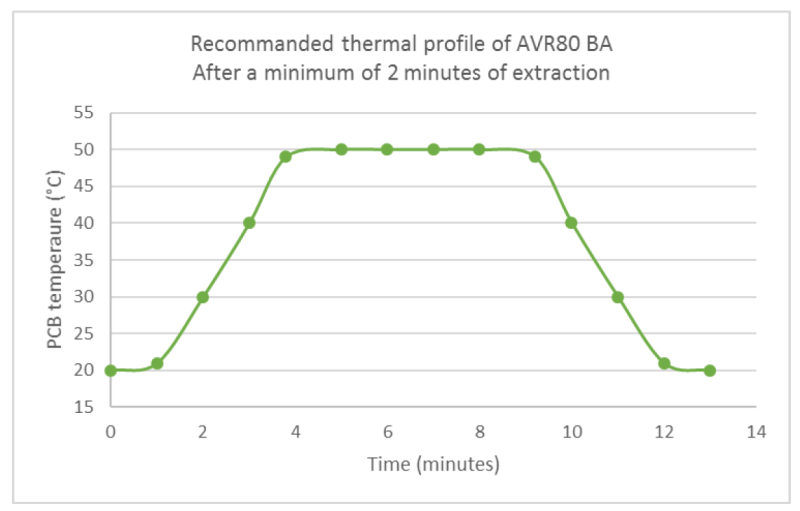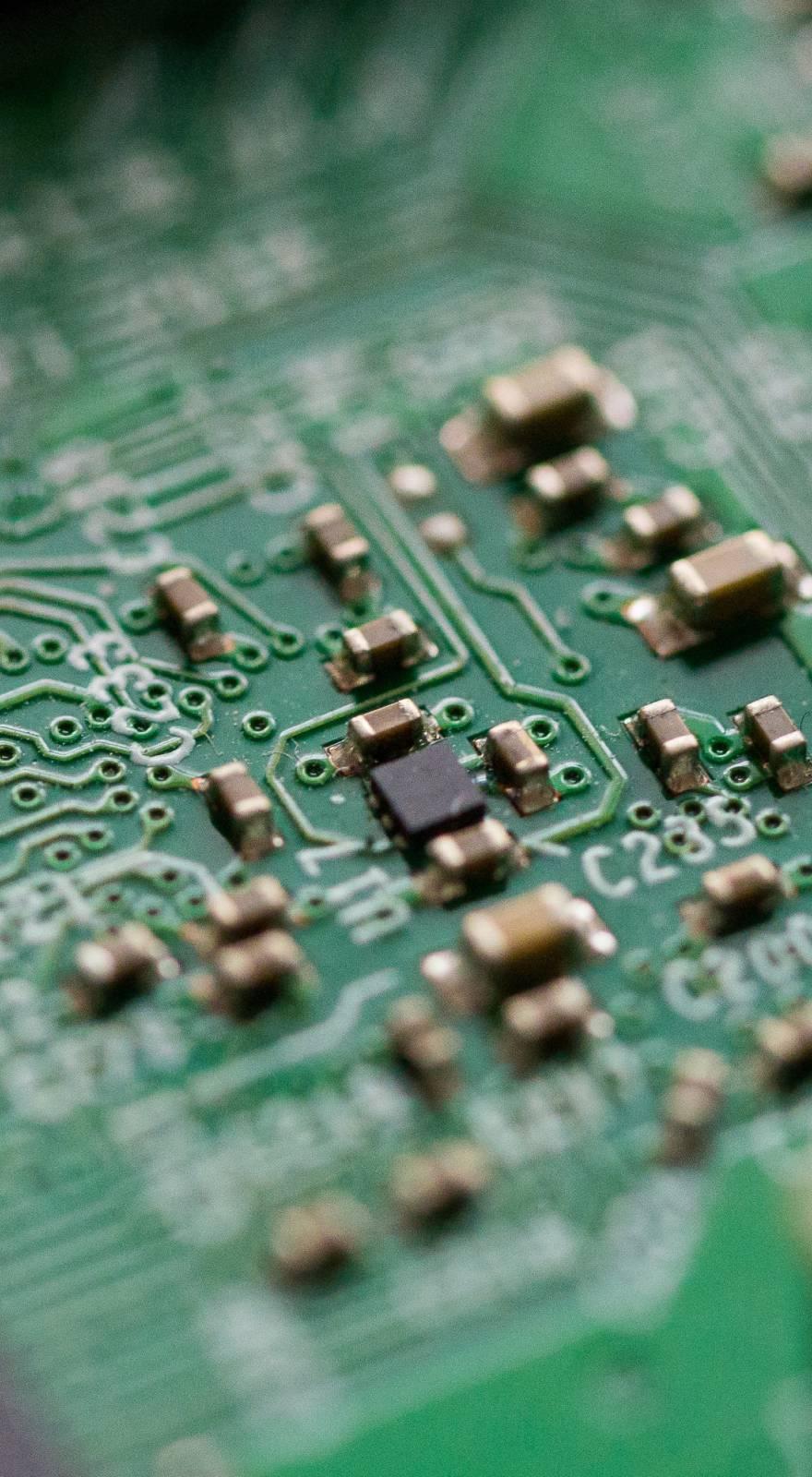Knowde Enhanced TDS
Identification & Functionality
- Chemical Family
- Product Type
- Technologies
- Product Families
Features & Benefits
- Labeling Claims
- Ready-to-Use Product Features
- Features
• Excellent adhesion under all climatic conditions,
• Fluoresces under UV light as an aid to inspection,
• Wide temperature range -65°C to +150°C,
• Can be soldered through without fear of highly toxic gasses being produced (contains no isocyanates),
• Resistant to mold growth,
• Can be totally removed with ABchimie SND or DNS,
• Compatible with other high specification acrylic coatings,
• Excellent Dielectric properties,
• UL94V0 approval. (File E308681),
• NF EN 61086-2 Approval,
• NF EN 45545, NF EN 16101, NF EN 16102 Approvals,
• Meets IPC-CC-830 and MIL-I-46058C,
• Halogen free.
Applications & Uses
- Markets
- Application Area
- Application Method
- Cure Method
- Applications
AVR80 BA can be sprayed, dipped or brushed. The thickness of the coating depends on the method of application, but a dip coater normally deposits a film thickness of about 25 microns (single coat). Workshop temperatures of less than 16°C or relative humidities in excess of 75% are unsuitable for the application of AVR80 BA. AVR80 BA contains a UV trace which allows inspection of the PCB after coating to ensure complete and even coverage. The stonger the reflected light, the thicker the coating layer is. Before coating, PCBAs should be clean, dry and without moisture. The CI, being composite materials, absorb moisture. It is important to remove it before coating. A passage in oven for 3 to 4 hours at 60°C is generally sufficient. After a soldering process, PCBAs can be coat immediately. If there is an intermediate storage up to 48 hours you will have to dry PCBAs. Homogenization of AVR80 BA is necessary before use. also be observed in the varnish AVR80 BA, then just mix the varnish before use.
Cleaning
AVR80 BA can be applied on uncleaned PCBAs. A cross cut test may to do to check the good adhesion on the PCBAs. Cleaning will increase adhesion on the substrat. ABchimie manufacture a range of 100% Ozone Friendly cleaning products in both the hydrocarbon solvent and aqueous fields. All products produce results within the Military specification (<1.56mg NaCL/cm2). Please contact ABchimie for further information.
Dip Coating
Ensure that the coating material in the container has been agitated thoroughly and has been allowed to stand for at least 2 hours for all the air bubbles to disperse. Acrylic Thinners (DVA BA) should be used to keep the AVR80 BA coating at a suitable viscosity for dipping. DVA BA is added periodically as the solvent evaporates. The viscosity should be checked using a viscosity meter or "flow cup" (Zahn 2). The board assemblies should be immersed in the AVR80 BA dipping tank in the vertical position, or at an angle as close to the vertical as possible. Connectors should not be immersed in the liquid unless they are very carefully masked. ABchimie Peelable Coating Mask (LDM) is ideal for this application.
Leave submerged for about 1 minute until the air bubbles have dispersed. The board or boards should then be withdrawn VERY SLOWLY (5 to 20 cm/mn) so that an even film covers the surface. After withdrawing, the boards should be left to drain over the tank until the majority of residual coating has left the surface. After the draining operation is complete, the boards should be placed in an air-circulating drying cabinet and left to dry.
Spraying
Bulk AVR80 BA needs to be thinned with DVA BA R before spraying. The optimum viscosity to give coating quality and thickness depends on the spray equipment and conditions but a starting point could be 1 parts coating to 1 part thinners. If bulk coating material has been agitated, allow to stand until air bubbles have dispersed. AVR80 BA is suitable both for use in manual spray guns and computer controlled airless spray equipment that only coats the required areas of the PCB, eliminating the need for masking. The nozzle of the spray gun requires to be selected to give an even spray to suit the prevailing viscosity of the coating material. To ensure penetration of the coating beneath the components and in confined spaces, spray the assembly from all directions to give an even coating. After spraying, the boards should be placed in an air-circulating drying cabinet and left to dry.
Brushing
Ensure that the coating material has been agitated thoroughly and has been allowed to settle for at least 2 hours. The coating should be kept at ambient temperature. Gently apply the coating with a good quality brush (silk) so as not to leave brush marks and so that the components and wiring are not disturbed. When the brushing operation is complete the boards should be placed in an air-circulating drying cabinet and left to dry.
Double Coating
Two coats of AVR80 BA are not usually required. However if two coats are required, the second coating should be applied after the first coating is dry. This will ensure that the two coats will bond satisfactorily.
Properties
- Physical Form
- Typical Properties
- Flowing mix gas
- OK (IEC 60068-2-60), (4 gas test/ 21d, 75% RH; 25°C; C12: 10ppm; No2: 200; H2S 10ppm; SO2 : 200 ppm)
| Value | Units | Test Method / Conditions | |
| Non-Volatile Content (22%Version DS65) | 0.3 | — | — |
| Viscosity (20°C, Bulk) | 245-300 | cSt | ASTM D4212 |
| Specific Gravity (20°C) | 0.93 | — | — |
| Flash Point | 25.0 | °C | — |
| Drying Time (24 hours Optimum Properties,Touch Dry) | max. 20 | minutes | — |
| Dielectric Strength | 50.0 | kV/mm | — |
| Insulation Resistance (Ω) | 10¹² | Ω | MIL-I-46058C |
| Dielectric Withstanding Voltage | min. 1500 | V | MIL-I-46058C |
| Temperature Range | -65 to +150 | °C | — |
| Flammability (UL94V0) | Self-Extinguishing | — | — |
| Dissipation Factor (1MHz, 25°C) | 0.01 | — | — |
| Glass Transition Temperature (Tg) | 29.0 | °C | — |
| Thermal Expansion Coefficient (If T <Tg) | 130.0 | ppm/°C | — |
| Thermal Expansion Coefficient (If T <Tg) | 280.0 | ppm/°C | — |
| CTI | min. 600 | — | DIN EN 60112 on FR4 |
| SIR test (95%RH, 7days) | 20 - 65 | °C | IPC CC 830 |
| Damp Heat Test (RH, 1000h, 85%) | 85.0 | °C | IEC 600068-2-67 |
| Salt Mist Test (5% salt, 48h) | 35.0 | °C | IEC 60068-2-11 |
| VRT ( 20 Cycles, Pente 10°C/mn) | -55 to +125 | °C | — |
| Thermal Chock (100 Cycles) | -65 to +125 | °C | IPC CC 830 |
| Thermal Chock (1500 Cycles) | -40 to +105 | °C | IEC 60068-2-14 |
Regulatory & Compliance
- Certifications & Compliance
Technical Details & Test Data
- Drying Times and Curing Conditions
AVR80 BA will be touch dry after 15 - 20 minutes at room temperature and does not require a thermal cure. The full properties of AVR80 BA will be obtained after a 24 hours at room temperature.
Immediate adhesion can be accelerated by the use of a thermal cure of 2 hours at 50°C. However solvants must be evaporated before heating.

This thermal profile can be adapted: ±10°C, depending some more parameters, such as: thickness deposit, design of the PCB...
Packaging & Availability
- Packaging Type
- Packaging
AVR80 BA Conformal Coating 400ml Aerosol (100% Ozone Friendly) AVR80 BA 400 5 Liters Bulk AVR80 BA 05L Acrylic Thinners 5 Liters DVA BA 05L 5 Liters DVA BA R 05L Removal Solvent SND (100% Ozone Friendly, Flammable) 400ml Aerosol SND 400B 5 Liter Bulk SND 05L 30 Liter Bulk SND 30L 5 Liter Bulk DNS 5L 30 Liter Bulk DNS 30L - Available Versions
AVR80 BA DS65 : For dispensing machine (viscosity at 65 cSt @25°C)
AVR80 BA DS83 : For dispensing machine (viscosity at 83 cSt @25°C)
AVR80 BA DS: Viscosity adapted at the customer needs
AVR80 BA 4060/4555/5050 : High viscosity versions
AVR80 BA GEL : Gel
Storage & Handling
- Storage Handling
Storage temperature: 5 to 30°C
A temporary lower temperature during few days (transport) doesn’t distort varnish properties.
Date by use: 18 months after the date of manufacturing (12 months in spray)

